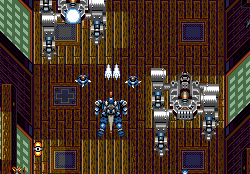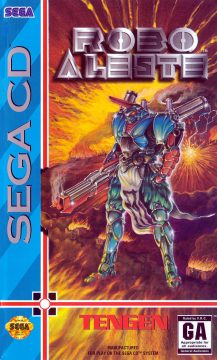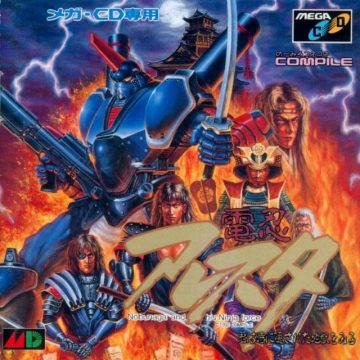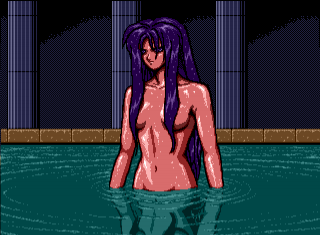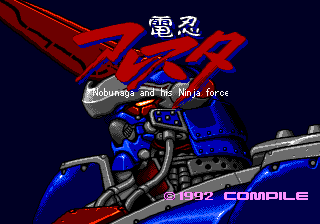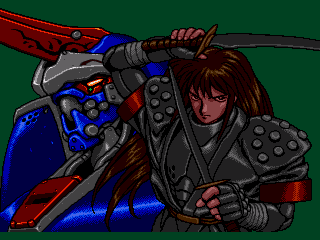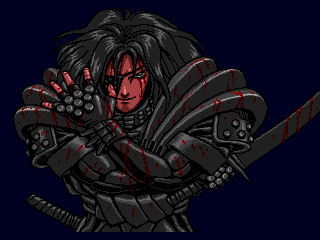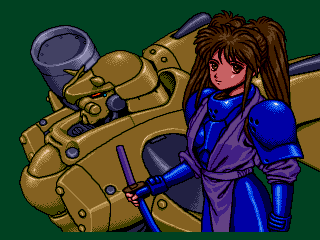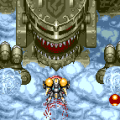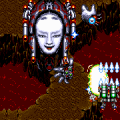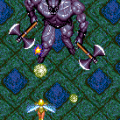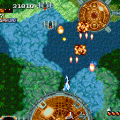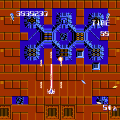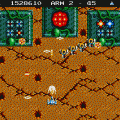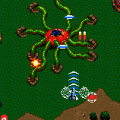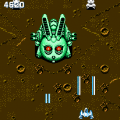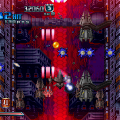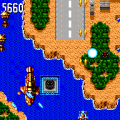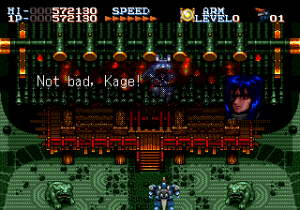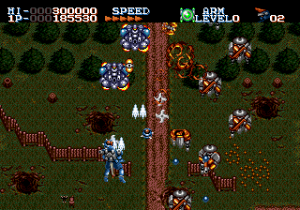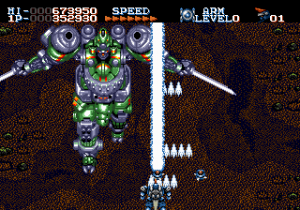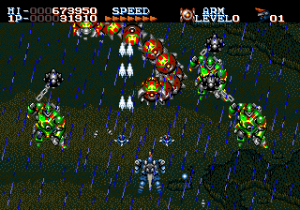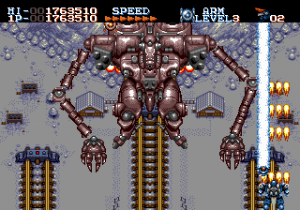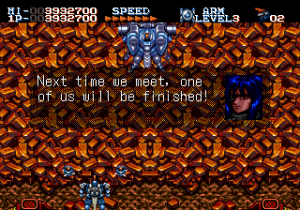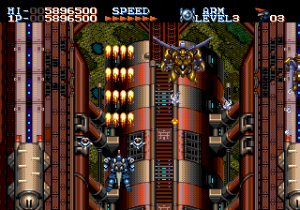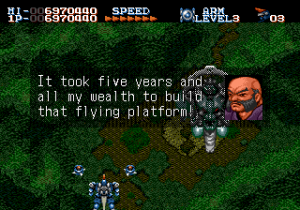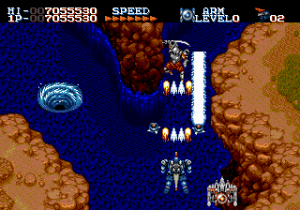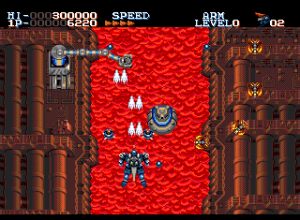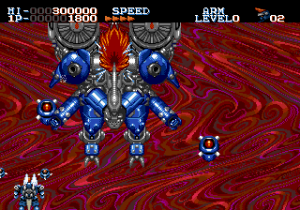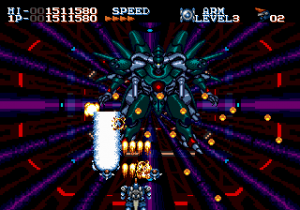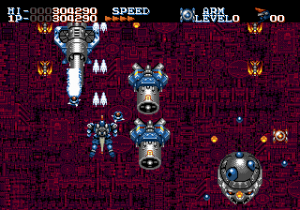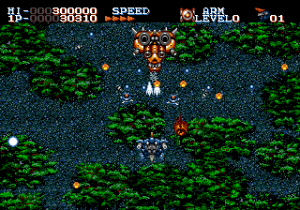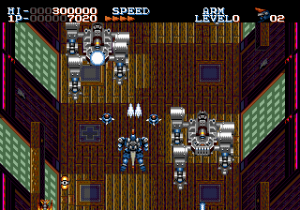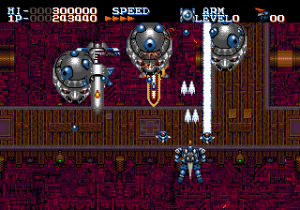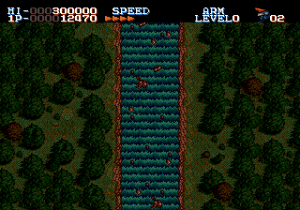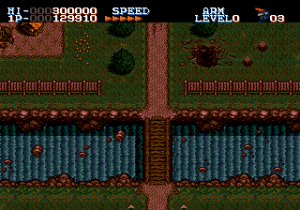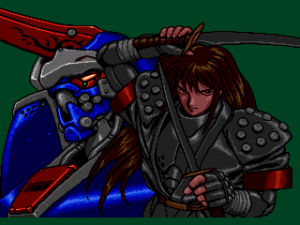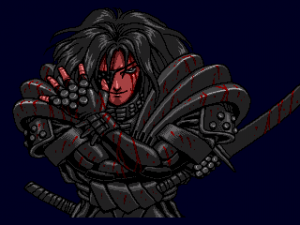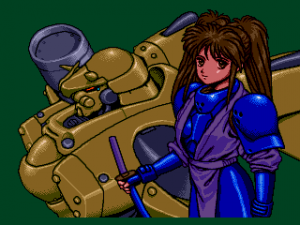Robo Aleste for the Sega CD is essentially the sequel to MUSHA. It begins with a relatively lengthy storyline that ties into Japanese history, particularly the Sengoku era and the rule of Nobunaga Oda. The hero is a mecha pilot named Kage, a warrior of the Oda clan, who fights against various feudal lords in protection of his master. He also has a long standing rivalry with his evil brother Tetsu, who is encountered several times throughout.
The game looks similar to MUSHA at a glance, but there are many, many differences that add up to a substantially different game. The power-up system is similar, though there are now four subweapons rather than three. The ARMs have been changed so that rather than selecting their behavior, they always hover just above the shoulders of your mecha. Despite their lack of versatility, they’re a little bit more powerful now, able to damage enemies if they touch them and absorb enemy fire. You can also charge and throw them like a boomerang, but since this requires that you temporarily stop firing your subweapon, this really isn’t all that useful.
The difficulty is also much higher. Even on the easiest difficulty level, even standard enemies take several hits to kill with the default weapon. They’re easier to take down with a fully powered up weapon, but it still takes a while before you can reach that level, and you’re knocked back down to the weakest state if you die. Speaking of which, one hit will always kill you, no matter how much weaponry you have.
MUSHA‘s greatest strength was how fast it was, and how it elicited the feeling of blazing through enemy lines, blasting down in a wave of fury. In contrast, Robo Aleste is strangely sedate. The pacing is slower, a little closer to the SNES’s Space Megaforce, and with weaker weapons, it doesn’t have the same sense of explosive gratification. Even the music, while catchy with a nice beat, is too laid back. A MUSHA-style soundtrack, done with live electric guitars a la Lords of Thunder, would’ve been amazing, but the style here is closer to some other Compile CD shooters like Spriggan Mark 2 and Sylphia.
The biggest issue with Robo Aleste, though, is that it’s really inconsistent. There are long stretches where the game is relatively easy, but they’re peppered with high difficulty spikes. The bosses are typically in gigantic mechas, far bigger than your own, that take up a bulk of the screen. Their designs are great – like MUSHA, they’re based on various elements of Japanese culture, like samurai outfits or kabuki costumes – but the animation is terrible, consistently using just a few choppy frames.
The first level begins with a gorgeous scene, with the Aleste flying over a waterfall, and scaling effects used as enemies fly in from above. But these effects are barely seen again, and many of the stages just take place over boring forests, fields, and caverns. That is, until the last stages of the game, with the final bosses accompanied by some incredibly cool animated effects. One is sort of a waving fiery red haze, and another looks almost like a short looping FMV of various colors, like a kaleidoscope. Both of these look very impressive for a 16-bit shooter, so it’s baffling that these are kept hidden until the very end.
One cool touch, at least, is that the story and characters are integrated slightly more into the game. Compile has been wanting to tell stories with their shooters since back in the MSX days, but these were just relegated to opening, ending, and sometimes mid-game cutscenes. In Robo Aleste, the characters talk to each other before fighting, or in the case of Kage, talks to himself. The dialogue is brief, but it does add a bit of flavor, like when Kage muses that he hopes Aleste’s joints don’t freeze up in the cold, or how the fifth level boss poured five years of his life and all of his fortune into the flying fortress you just destroyed.
Still, in spite of the overly detailed backstory, the plot feels incomplete. Saeba, the heroine, is introduced halfway through, but she barely has any role in the story, even less than the usual Compile shooter heroine. And the game’s story was left open for a sequel, which was planned but eventually canceled. All in all, Robo Aleste isn’t bad, but its poor balance and generally unfinished feeling relegates it to the lesser tiers of Compile’s shooter library.
Robo Aleste was released in North America by Tengen, who also localized Toaplan’s Grind Stormer for the Genesis. They actually kept all of the Japanese historical references, though the introduction cinema is rather dry thanks to the boring voiceover, and the later cutscenes have fairly bad voice acting, too. The title screen was also changed into something far less cool than the Japanese version, plus they removed a handful of secret character portraits. The mid-game cutscene was also altered to remove a shot of Astaros, one of the antagonists, getting out of the bath, probably to maintain a GA (General Audiences) rating.
The Japanese version has several bonus audio tracks that correspond to the in-game dialogue. These are unused since they’re normally just done in text, but they’re a cool bonus to listen to. These segments were not dubbed for the English release and the tracks were removed entirely from the disc.
In Japan, the game is called Dennin Aleste, “dennin” meaning “electric ninja”. It was originally conceived under the name Rainin Aleste, “rainin” meaning “thunder ninja”. However during a planning meeting, one of the staff members drew the wrong kanji on a meeting room whiteboard (“den – 電“ and “rai – 雷“ look extremely similar) and the developers ultimately thought it sounded better.
